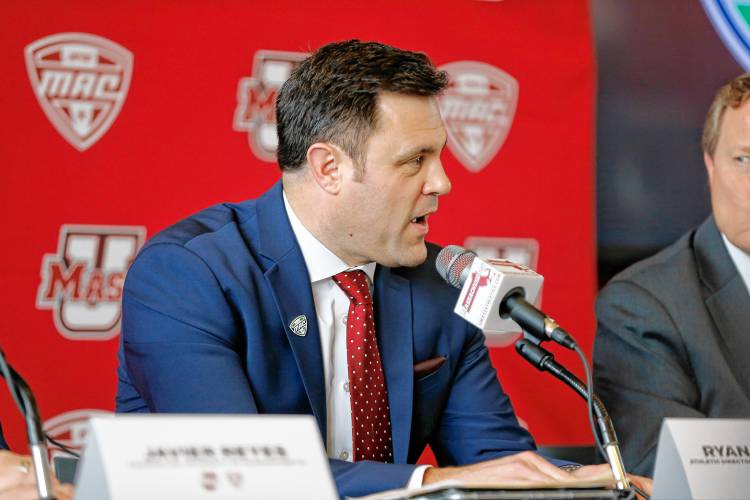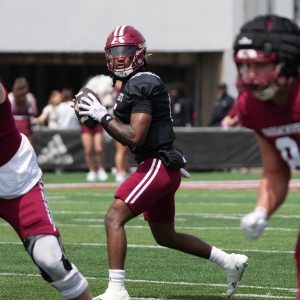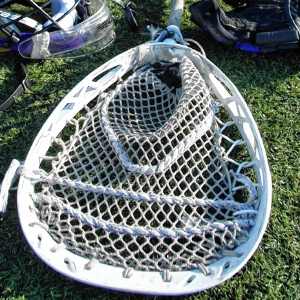Breaking down the financial implications for UMass athletics after move to the Mid-American Conference

UMass Director of Athletics Ryan Bamford speaks during a press conference at the Martin Jacobson Football Performance Center earlier this month regarding the University of Massachusetts joining the Mid-American Conference. STAFF PHOTO/DAN LITTLE
|
Published: 03-19-2024 6:17 PM
Modified: 03-20-2024 4:32 PM |
When UMass joins the Mid-American Conference for the 2025-26 academic year, athletic director Ryan Bamford expects the school will bring in more revenue than it did when competing in the Atlantic 10.
“This will allow us to grow our revenues to the department by anywhere from 8-10 times from what we’re currently seeing from a conference standpoint,” Bamford said at the introductory press conference announcing the conference move earlier this month.
Bamford also said that UMass will enter as the “highest-resourced” athletic department in the conference.
“We’re always going to compare ourselves to the 12 MAC schools, but I want to look at our peer institutions, our aspirational peers, what are they doing?” Bamford said. “This is a chance for us to really push the envelope on investment in athletics, and especially in the sports of football and men’s and women’s basketball.”
UMass spent $41,443,787 on athletics, including athletics waivers, during the 2022 fiscal year, an increase from $33,339,993 during the 2021 fiscal year. According to data from the Knight Commission on Intercollegiate Athletics, MAC schools spent between $24,097,387 (Northern Illinois) and $39,537,565 (Buffalo) on athletics in 2022. UMass spent $11 million on football and $4.5 million on men’s basketball in 2022.
The Atlantic 10 does not sponsor FBS football. When UMass moved up to the FBS level in 2012, it competed as an affiliate member in the MAC for four years, going 8-40. Bamford hopes that increased investment can help the program succeed in the conference, now that they’re a full member. He said that UMass was 12th or 13th in spending and coaching salaries during its previous tenure as a MAC affiliate school.
“When we go into the MAC in two years, we will be number one in all of those categories,” Bamford said.
This fall, the College Football Playoff will expand from four to 12 teams. Last week, the CFP and ESPN agreed in principle to a new six-year deal worth $1.3 billion annually.
Article continues after...
Yesterday's Most Read Articles
 Police report details grisly crime scene in Greenfield
Police report details grisly crime scene in Greenfield
 Super defers Amherst middle school principal pick to successor; one finalist says decision is retaliation for lawsuit
Super defers Amherst middle school principal pick to successor; one finalist says decision is retaliation for lawsuit
 Homeless camp in Northampton ordered to disperse
Homeless camp in Northampton ordered to disperse
 Authorities ID victim in Greenfield slaying
Authorities ID victim in Greenfield slaying
 Haydenville residents resist Greenway trail plan, float alternative design
Haydenville residents resist Greenway trail plan, float alternative design
 Locking up carbon for good: Easthampton inventor’s CO2 removal system turns biomass into biochar
Locking up carbon for good: Easthampton inventor’s CO2 removal system turns biomass into biochar
However, that money is not spread evenly among the conferences. The Big Ten and SEC will receive more than half of the revenue distribution and the Group of Five (American Athletic, Mid-American, Mountain West, Conference USA, Sun Belt) will reportedly see 9% – or about $115 million – of the revenue, though that number may not be evenly distributed among the teams and conferences themselves. In 2023, there were 61 schools in Group of Five conferences.
Group of Five schools will also not see as much of an increase in the latest renegotiation as their larger counterparts. While the Power Two (Big Ten and SEC) will see increases from about $5.5 million per school to $21 million per school, Group of Five schools will only see an increase from $1.5 million to $1.8 million. Group of Five athletic directors weren’t happy about this increase, but had little negotiating power and feared being left out of the playoff entirely.
Under the four-team playoff format from 2013-2023, the only Group of Five team selected was Cincinnati in 2021. Under the new format, the Group of Five is guaranteed to have at least one team in the playoff, which is now made up of the five highest-ranked conference champions and seven at-large bids.
As an independent, UMass could have made money from playing in a bowl game, though it didn’t win the requisite six games to reach one. However, UMass did make money from playing “buy games,” where a Power Five program pays them to travel to their stadium.
Seven times in the last four years, UMass has been paid more than $1 million to travel to a Power Five opponent. Last year, Auburn paid UMass $1.95 million to beat them 59-14 and Penn State paid the Minutemen $1.6 million in a 63-0 thumping.
After next year though, UMass will have most of its schedule occupied with conference games. Bamford estimated they would still play a “buy game” against a Power Five opponent once a year.
Bamford also said that UMass will try to outspend most of its competitors in Name, Image, Likeness (NIL) money. UMass has two officially endorsed collectives, “The Midnight Ride Collective” and “The Massachusetts Collective.”
“The MAC in basketball, from an NIL perspective, is doing very little,” Bamford said. “We’re going to go in and we’re going to be spending probably half a million dollars a year in NIL collective money for men’s basketball.
“(It’s a) little bit more defined in football for the MAC in the NIL space,” Bamford added. “There’s a handful of schools that are doing things there.”
As the gap between the have and have-nots widens, players who succeed at Group of Five schools often transfer to bigger programs. Of the six MAC football programs to make a bowl game last year, three lost their starting quarterback to the transfer portal (including 2023 MAC MVP Dequan Finn of Toledo), two return their starter for 2024 and Northern Illinois graduated its starter.
In 2014, the MAC signed a contract extension with ESPN as its exclusive carrier for all TV. ESPN holds distribution rights for football and men's basketball, as well as select women's basketball and Olympic sports events. The deal runs until 2026-27 for a reported $10 million per year, split among the member schools for about $800,000 per school. However, the world of college athletics and sports media has changed drastically in the decade since its signing.
Here’s a look at the media rights deals other Group of Five conferences have signed recently:
Conference USA: signed a five-year deal in 2022 with CBS and ESPN that pays each member school a reported $750,000.
Sun Belt: signed a nine-year deal in 2022 with ESPN that pays each member school a reported $1.2 million.
Mountain West: signed a six-year deal in 2020 with CBS and FOX that pays each member school a reported $4 million.
American Athletic Conference: signed a 12-year deal in 2019 with ESPN that pays each member school a reported $5 million.
In addition to any deal the MAC signs, Bamford said that he has been talking with the MAC about broadcasting men’s and women’s basketball as well as UMass’ Olympic sports on NESN. If that arrangement were to happen, ESPN would sublicense those games to NESN.
“That would be a goal of ours because of the footprint of our alumni base,” Bamford said. “...There are still some traditionalists to where being on NESN is a real advantage. You’ve got the Bruins and the Red Sox on there as well, I think it’s a go-to channel for the sporting enthusiasts of the region.”
Bamford also acknowledged that UMass will have to pay an exit fee to the Atlantic 10 and an entry fee to the MAC. He said those figures will be public in the “next couple months.”
“Those figures will probably be public once we get to a point where the framework of the agreement with the MAC is done,” Bamford said. “That’s already been negotiated, but there are a bunch of other points we have to finish up – non-fiduciary, non-financial points.”

 UMass football: Spring Game closes one chapter for Minutemen, 2024 season fast approaching
UMass football: Spring Game closes one chapter for Minutemen, 2024 season fast approaching High schools: Furious fourth quarter rally falls just short for South Hadley boys lacrosse
High schools: Furious fourth quarter rally falls just short for South Hadley boys lacrosse  Softball: Hampshire rallies from early deficit, slugs past Easthampton 10-4 (PHOTOS)
Softball: Hampshire rallies from early deficit, slugs past Easthampton 10-4 (PHOTOS) 2024 Gazette Girls Basketball Player of the Year: Ava Azzaro, Northampton
2024 Gazette Girls Basketball Player of the Year: Ava Azzaro, Northampton
